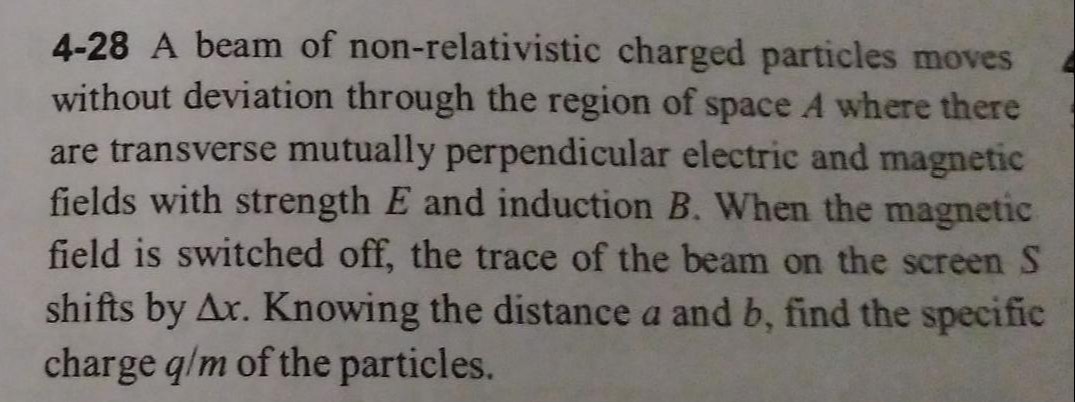Question
Question: A beam of non-relativistic charged particles moves without deviation through the region of space A w...
A beam of non-relativistic charged particles moves without deviation through the region of space A where there are transverse mutually perpendicular electric and magnetic fields with strength E and induction B. When the magnetic field is switched off, the trace of the beam on the screen S shifts by Δx. Knowing the distance a and b, find the specific charge q/m of the particles.

aB2(a+2b)2ΔxE
Solution
The problem describes two scenarios for the motion of non-relativistic charged particles:
Scenario 1: Velocity Selector (E and B fields present)
A beam of charged particles moves without deviation through a region of space A where there are mutually perpendicular electric field (E) and magnetic field (B). For the particles to move undeflected, the electric force (Fe=qE) must balance the magnetic force (Fm=qvB).
qE=qvB
From this, the velocity of the particles (v) is determined:
v=BE
This is the principle of a velocity selector.
Scenario 2: Deflection by Electric Field (B field switched off)
When the magnetic field is switched off, only the electric field E acts on the particles in region A. The electric field is transverse to the initial velocity of the particles. Let the length of region A be 'a'. The time taken for a particle to traverse region A is tA=va. During this time, the particle experiences a constant electric force Fe=qE in the transverse direction. This force causes an acceleration ay=mFe=mqE in the transverse direction.
- Deflection within region A:
The transverse displacement (yA) of the particle when it exits region A is:
yA=21aytA2=21(mqE)(va)2=2mv2qEa2
- Transverse velocity at exit from region A:
The transverse velocity (vy) acquired by the particle when it exits region A is:
vy=aytA=(mqE)(va)=mvqEa
- Deflection after exiting region A:
After exiting region A, the particles travel a distance 'b' to the screen S. In this region, there are no fields, so the particles move in a straight line with the velocity components (v,vy). The time taken to travel this distance 'b' is tb=vb. The additional transverse displacement (yb) during this travel is:
yb=vytb=(mvqEa)(vb)=mv2qEab
- Total shift on screen S:
The total shift Δx on the screen S is the sum of the deflections from both parts:
Δx=yA+yb=2mv2qEa2+mv2qEab
Δx=mv2qEa(2a+b)
- Substitute velocity and solve for specific charge:
Now, substitute the velocity v=BE (from Scenario 1) into the equation for Δx:
Δx=m(E/B)2qEa(2a+b)
Δx=mE2qEaB2(2a+b)
Δx=mEqB2a(2a+b)
Rearrange the equation to find the specific charge mq:
mq=aB2(2a+b)ΔxE
To simplify the denominator:
mq=aB2(2a+2b)ΔxE
mq=aB2(a+2b)2ΔxE
The specific charge q/m of the particles is aB2(a+2b)2ΔxE.
